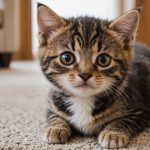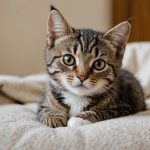Understanding FIV and FeLV in Cats
FIV (Feline Immunodeficiency Virus) and FeLV (Feline Leukaemia Virus) are significant feline health issues, each affecting cats in distinct ways. Both are retroviruses, yet their causes, transmission methods, and effects differ.
FIV is primarily spread through deep bite wounds, often in outdoor or aggressive cats. Once a cat is infected, FIV attacks the immune system, leading to increased susceptibility to infections. However, affected cats can lead long, healthy lives with proper care.
Lire également : Welcoming a New Baby: Essential Tips for Easing Your Cat”s Transition
In contrast, FeLV transmission occurs through prolonged intimate contact — such as grooming or sharing of food and water bowls. It can cause anaemia, cancers, or suppress the immune system. Unlike FIV, FeLV often has a poorer prognosis.
For caregivers, understanding these distinctions is crucial. Considering enrichment for FIV or FeLV positive cats is essential to their well-being. Interactive toys, comfortable resting areas, and social interaction help in maintaining their physical and mental health.
A voir aussi : Essential Tips for Ensuring a Stress-Free Vet Visit for Your Cat
In summary, while FIV and FeLV both pose challenges, their management requires different approaches. Awareness and differentiation between these two {feline health issues} are vital for ensuring a better quality of life for affected cats.
The Importance of Indoor Enrichment for Cats
Indoor enrichment plays a vital role in maintaining a cat’s overall well-being. A stimulating environment is essential for reducing anxiety and boredom. Cats are naturally curious and active, and without the proper mental and physical activities, they can develop behavioural issues or even health problems.
Providing varied and engaging activities ensures that cats are mentally engaged. This boosts their mental health significantly and minimizes the risks of stress-induced behaviours. Some great ways to enhance cat stimulation include interactive toys, puzzle feeders, and climbing structures.
For cats with FIV or FeLV, maintaining physical activity is equally crucial. These indoor activities are not just beneficial for typical household cats but are also essential for those with specific health conditions, like FIV (Feline Immunodeficiency Virus) or FeLV (Feline Leukemia Virus). These conditions can weaken a cat’s immune system, making them more susceptible to infections.
However, their need for play remains, which makes indoor enrichment even more crucial. Simple activities like chasing laser pointers or pouncing on feather toys can help keep them active.
A stimulating environment can bring about numerous behavioural benefits. It can reduce aggression, promote healthy social interactions, and ensure overall contentment. Understanding these needs can greatly enhance a cat’s indoor life.
Creative Strategies for Indoor Play
Entertaining your feline friend indoors is all about combining interactive toys with engaging play activities. Cats are natural hunters, so using toys as stimulation can mimic this instinct, keeping them happy and healthy.
Using Puzzle Toys to Engage Cats
Puzzle toys are a fantastic way to captivate your cat’s attention. These toys, especially food-dispensing variants, can encourage problem-solving abilities. Imagine a toy that challenges your cat to figure out how to unlock a treat—such puzzles stimulate their mind and keep them occupied. It’s crucial to introduce such a toy gradually, showing your cat how to interact with it for maximum benefit.
DIY Cat Toys and Activities
Creating your own DIY cat toys is both rewarding and practical. You can fashion toys from everyday items like cardboard boxes or old t-shirts. For a simple project, consider making a cat wand by tying feathers or ribbons to a stick. These homemade toys allow you to cater specifically to your cat’s preferences and are budget-friendly, too.
Interactive Play with Owners
Regular interactive play sessions are a golden opportunity to bond with your cat. Incorporate toys like laser pointers or feather wands, which allow your cat to chase and jump. Such activities not only fulfill their play drive but also promote physical exercise. Remember, the key is to be actively involved, making these moments exciting and enriching for your furry companion.
Environmental Modifications for Enrichment
Creating cat-friendly spaces at home can significantly enhance your cat’s well-being. Begin by considering the importance of a stimulating yet secure environment. Cats naturally enjoy climbing, so incorporate vertical space by adding cat trees or shelves. These additions allow your cat to exercise and satisfy their natural curiosity.
Safe spaces are equally crucial for a cat’s comfort and security. Ensure there are hiding spots where your feline friend can retreat to when they need solitude. A cat’s environment should mimic their instincts, offering a blend of exploration and safety.
In terms of environmental design, balance is key. Think about creating zones that cater to different activities. For example, a quiet corner for napping, a sunny spot for lounging, and an interactive area for play.
Integrating these elements into your home can provide comprehensive enrichment. You can encourage positive behaviour while addressing your cat’s innate needs.
To create spaces that your cat will love:
- Use multi-level structures for varied climbing options
- Ensure easy access to spots that offer both sanctuary and fun
Remember, a well-designed environment is not just about aesthetics—it’s about promoting a happy and healthy life for your pet.
Incorporating Sensory Enrichment
Enriching a cat’s environment through sensory stimulation can play a significant role in their overall happiness and well-being. This involves engaging their senses in unique and varied ways, including textures, scents, and visual stimuli.
The Use of Different Textures
Felines react to diverse textures by employing their sense of touch, often leading to heightened engagement and curiosity. Materials such as soft fleece, crunchy paper, or rough sisal rope can create stimulating elements in their environment. Cats tend to investigate surfaces with their paws and whiskers, so incorporating a variety of textures can enhance their sensory experience, possibly even stimulating playful behavior or satisfying innate exploration desires.
Introducing New Scents
Introducing cat scents is another way to stimulate their olfactory senses naturally. Safe floral aromas such as lavender or chamomile, as well as synthetic pheromone diffusers, can create a calming atmosphere. These scents can help manage stress or anxiety. Remember to introduce new scents gradually to ensure your feline friend does not feel overwhelmed.
Visual Stimulation Techniques
To foster visual enrichment, consider arranging areas with contrasting colors and patterns. Distinct visual elements can capture a cat’s attention akin to how toys do. Consider setting up spaces that encourage exploration or rest, ensuring areas are safe and accessible, which will allow your cat to fully benefit from the visual stimulation.
Socialization and Companionship Strategies
Understanding the nuances of cat socialization is crucial, especially when considering them as companion animals. Socializing a cat can enhance its quality of life and reduce behavioural issues. Introducing cats to new environments or companions should be done thoughtfully, respecting their space and comfort levels. Group play emerges as a pivotal technique, promoting exercise and mental stimulation while fostering a sense of community among pets.
When introducing new pets, especially to FIV or FeLV-positive cats, caution and knowledge are vital. These cats can often lead fulfilling lives with other animals, but monitoring their health and interactions is imperative. The introduction should be gradual, allowing all animals to acclimate at their pace. Health considerations, such as vaccination and regular vet visits, help safeguard against potential risks, ensuring that both new and existing pets enjoy harmonious coexistence.
In addition to physical interactions, enriching the environment can play a role in effective socialization. Providing toys, scratching posts, and interactive spaces encourages exploration and mutual play. By focusing on the needs and tendencies of cats, socialization can transform their living space into an engaging habitat that nurtures their social and emotional well-being.
Health Considerations and Safety Tips
Caring for a pet involves responsible health management, particularly for those with unique needs such as sick cats. It is crucial to maintain routine veterinary check-ups and follow-up care to ensure your cat receives timely vet advice. These visits allow for regular vaccinations and early detection of potential health issues.
Understanding your cat’s limitations based on their health status is vital. Each cat may have different needs, especially if they have chronic conditions or are recovering from illness. For instance, a cat with mobility issues may require modifications to its environment to better accommodate its limitations, such as accessible litter boxes or feeding stations.
Safety for sick cats also extends to their playtime activities. While it is essential to keep them stimulated, it is equally important to choose toys and games that are appropriate for their energy levels and health conditions. Avoid overly strenuous activities that could cause stress or injury. Toys should be easily reachable and not require excessive jumping or climbing.
Consulting with your vet can provide more personalized safety tips and recommendations tailored to your cat’s specific health needs, ensuring their well-being and a better quality of life. Prioritizing these safety measures contributes greatly to the overall health management of your feline friend.
Resources and Expert Insights
Navigating the complexities of caring for cats with FIV (Feline Immunodeficiency Virus) and FeLV (Feline Leukemia Virus) may be challenging. Fortunately, numerous resources and professional guidance avenues can provide much-needed support and expert advice.
Many reputable organizations and websites specialize in educating feline owners about FIV and FeLV, offering invaluable information and cat care resources. For instance, the American Association of Feline Practitioners and the Cornell Feline Health Center are fantastic starting points for understanding these conditions. They offer scientific findings, treatment options, and management strategies to improve your pet’s quality of life.
Another crucial component in crafting a well-rounded care plan for your cat is consulting with your veterinarian. They can develop tailored enrichment plans specifically suited to your cat’s needs. This ensures a holistic approach that considers your cat’s unique health profile.
For additional support and community interaction, online forums and cat care communities can be incredibly helpful. These platforms enable caregivers to share experiences, ask questions, and gain comfort and reassurance from fellow pet owners facing similar challenges. Engaging in these conversations can alleviate feelings of isolation and empower caregivers with shared knowledge and expert insights.










